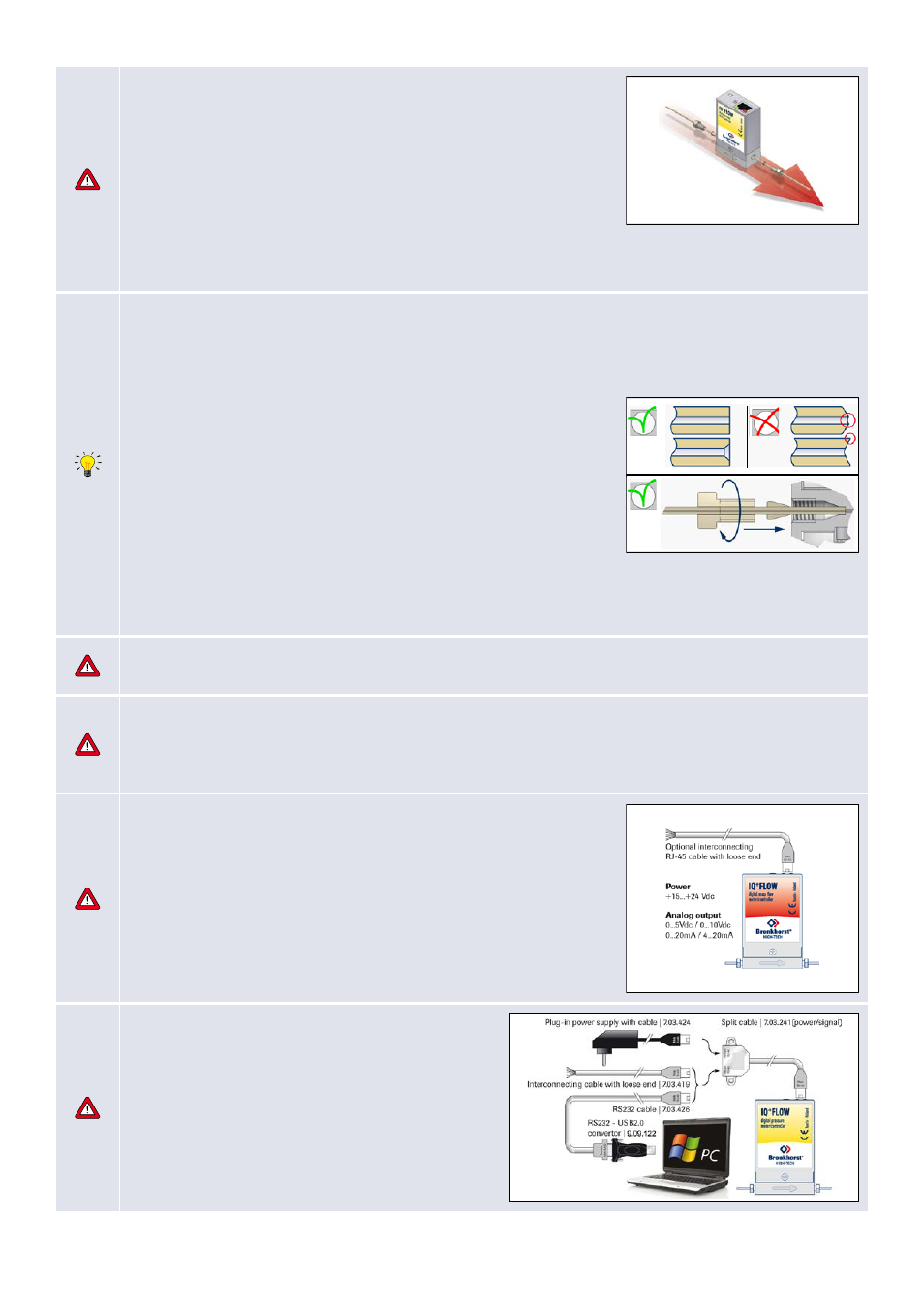Scope of this guide, Starting-up – Bronkhorst IQ+FLOW Quick Start User Manual
Page 3

9.17.074
2
SCOPE OF THIS GUIDE
IQ
+
FLOW
®
digital mass flow/pressure meters and controllers for gases are one of the smallest chip based instruments
of its kind. IQ
+
FLOW® mass flow meters/controllers can be applied for measuring and fast control of gas flows up to
5000 mln/min, for applications with pressure conditions up to 10 bar (145 psi) and temperatures between 5 and 50 °C
(41 to 122 °F). IQ
+
FLOW
®
pressure meters/controllers can be applied for pressure ranges from 0,01…0,5 bar up to
0,2…10 bar. The instruments can either be operated in analog or digital mode (RS232 or RS485).
This guide covers the short-form instructions for IQ
+
FLOW
®
instruments regarding:
start-up
mounting
zeroing
operation
This manual will help you start-up your IQ
+
FLOW
®
in 10 steps. More information can be found in documents listed below:
Instruction manual IQ
+
FLOW
®
series
(document nr. 9.17.045)
Consists information for basic and advanced operation, more detailed product information and instructions for
troubleshooting
FlowPlot Manual
(document nr. 9.17.030)
Hook-up diagram IQ
+
FLOW
®
Single-channel
(document nr. 9.16.101)
Hook-up diagram IQ
+
FLOW
®
Multi-channel
(document nr. 9.16.090)
These documents can be downloaded from the website: www.bronkhorst.com or can be sent by e-mail on request.
Starting-up
1. Check IQ
+
FLOW properties
Before installing it is important to read the attached label and check:
Instrument type:
- gas (IQF) red label or
- pressure (IQP) yellow label
Flow rate
Fluid to be measured / controlled
Up- and downstream pressure
Input and output signals
Temperature
IQ(F/M) - Gas Flow IQP - Pressure
Output/Setpoint
A – 0…5 Vdc
B – 0…10 Vdc
F – 0…20 mA
G – 4…20 mA
IQ
+
FLOW
®
instruments are designed for dry, clean, inert and non-explosive gases. Do not use the instruments for
gases that do not belong to this category.
2. Check test-pressure
The tested pressure is stated on the instrument with a red-coloured sticker.
Before installation, make sure that the test pressure is in accordance with
normal safety factors for your application. If there is no Pressure Testing
Sticker on the device or if the test pressure is incorrect, the instrument
should not be mounted in the process line and be returned to the factory.
3. Check if system piping is clean
For reliable measurement always make sure that the fluid stream is clean.
Use filters to ensure a clean, moisture- and oil- free gas stream.
Recommended pore-size: 7 µm. If back flow can occur, a downstream filter is
recommended too. Be aware of the pressure drop caused by using filters.
© 2015 Bronkhorst High-Tech B.V.
3
4a. Mount / install instrument properly
For IQ
+
FLOW® the upright position is preferred. When using an IQ
+
FLOW®
instrument in up- or downward position make sure to “zero” the instrument
prior to use (see step 10). Avoid installation in close proximity of mechanic
vibration and/or heat sources. The housing of the instrument is according to
class IP40, which means that the instrument is suitable for indoor (dry)
applications, like laboratories or well protected (OEM) housings.
Install the IQ
+
FLOW® instrument in the line, in accordance with the direction of the FLOW arrow. The arrow for
flow direction is indicated on the body of the instrument. If applicable follow the guidelines of the supplier of the
fittings. Special types of fittings are available on request.
4b. Compression type fittings
For leak tight installation of compression type fittings make sure that the tube is inserted up to the shoulder in the
fitting body and that no dirt or dust is present on tube, ferrules or fittings. Tighten the nut finger tight; while
holding the instrument, then tighten the nut one turn.
4c. 10-32 UNF fittings
Tighten the 10-32 UNF fittings according to the instructions of the supplier
of the fittings.
Only use 1/16” tubing with a straight and clean cut without burrs to ensure
leak tightness. Preferably deburr the tubing prior to installation. A new
ferrule connection must be made for each new adapter to ensure leak-
tightness and minimum dead volume, due to variances in the adapter
dimensions.
4d. Mounting downported instruments
For downported instruments make sure that the seals are present at the bottom, that the surfaces are undamaged
and that they are dry and free from dirt or dust.
5. Leak check
Check the system for leaks before applying pressure. Especially if toxic or other dangerous fluids are used!
6. Electrical connection
Electrical connections must be made with a standard cable or according to the IQ
+
FLOW® hook-up diagram. These
diagrams can be found on the “Documentation and software tools” CD-ROM and at the download section of
www.bronkhorst.com. IQ
+
FLOW® instruments are powered with +15…+24 Vdc.
7a. Analog operation (For Single-channel versions only):
For analog operation refer to the “Hook-up diagram IQ
+
FLOW®” or use an
RJ45 loose-end cable (7.03.419) to connect the required signals.
7b. Digital RS232 operation
Digital operation over RS232 can be established when
using the following setup. Using a RS232 cable or a USB-
RS232 converter with a PC will allow you to use (free)
Bronkhorst® software for Windows, such as FlowDDE and
FlowPlot.
